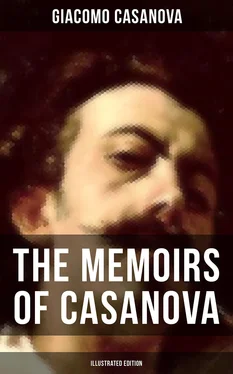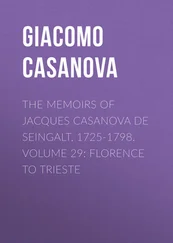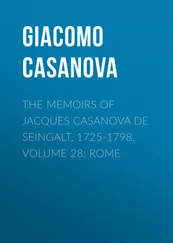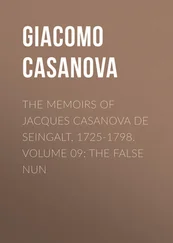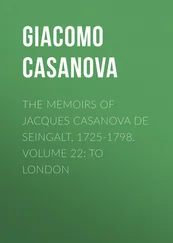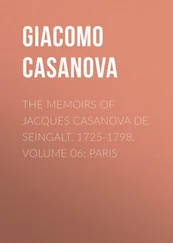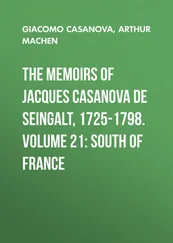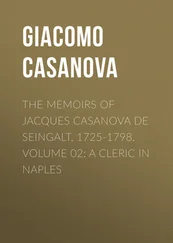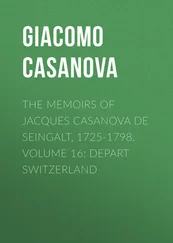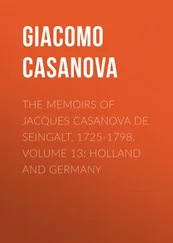Casanova died in 1798, but nothing was heard of the Memoirs (which the Prince de Ligne, in his own Memoirs, tells us that Casanova had read to him, and in which he found 'du dyamatique, de la rapidite, du comique, de la philosophie, des choses neuves, sublimes, inimitables meme') until the year 1820, when a certain Carlo Angiolini brought to the publishing house of Brockhaus, in Leipzig, a manuscript entitled Histoire de ma vie jusqu a l'an 1797, in the handwriting of Casanova. This manuscript, which I have examined at Leipzig, is written on foolscap paper, rather rough and yellow; it is written on both sides of the page, and in sheets or quires; here and there the paging shows that some pages have been omitted, and in their place are smaller sheets of thinner and whiter paper, all in Casanova's handsome, unmistakable handwriting. The manuscript is done up in twelve bundles, corresponding with the twelve volumes of the original edition; and only in one place is there a gap. The fourth and fifth chapters of the twelfth volume are missing, as the editor of the original edition points out, adding: 'It is not probable that these two chapters have been withdrawn from the manuscript of Casanova by a strange hand; everything leads us to believe that the author himself suppressed them, in the intention, no doubt, of re-writing them, but without having found time to do so.' The manuscript ends abruptly with the year 1774, and not with the year 1797, as the title would lead us to suppose.
This manuscript, in its original state, has never been printed. Herr Brockhaus, on obtaining possession of the manuscript, had it translated into German by Wilhelm Schutz, but with many omissions and alterations, and published this translation, volume by volume, from 1822 to 1828, under the title, 'Aus den Memoiren des Venetianers Jacob Casanova de Seingalt.' While the German edition was in course of publication, Herr Brockhaus employed a certain Jean Laforgue, a professor of the French language at Dresden, to revise the original manuscript, correcting Casanova's vigorous, but at times incorrect, and often somewhat Italian, French according to his own notions of elegant writing, suppressing passages which seemed too free-spoken from the point of view of morals and of politics, and altering the names of some of the persons referred to, or replacing those names by initials. This revised text was published in twelve volumes, the first two in 1826, the third and fourth in 1828, the fifth to the eighth in 1832, and the ninth to the twelfth in 1837; the first four bearing the imprint of Brockhaus at Leipzig and Ponthieu et Cie at Paris; the next four the imprint of Heideloff et Campe at Paris; and the last four nothing but 'A Bruxelles.' The volumes are all uniform, and were all really printed for the firm of Brockhaus. This, however far from representing the real text, is the only authoritative edition, and my references throughout this article will always be to this edition.
In turning over the manuscript at Leipzig, I read some of the suppressed passages, and regretted their suppression; but Herr Brockhaus, the present head of the firm, assured me that they are not really very considerable in number. The damage, however, to the vivacity of the whole narrative, by the persistent alterations of M. Laforgue, is incalculable. I compared many passages, and found scarcely three consecutive sentences untouched. Herr Brockhaus (whose courtesy I cannot sufficiently acknowledge) was kind enough to have a passage copied out for me, which I afterwards read over, and checked word by word. In this passage Casanova says, for instance: 'Elle venoit presque tous les jours lui faire une belle visite.' This is altered into: 'Cependant chaque jour Therese venait lui faire une visite.' Casanova says that some one 'avoit, comme de raison, forme le projet d'allier Dieu avec le diable.' This is made to read: 'Qui, comme de raison, avait saintement forme le projet d'allier les interets du ciel aux oeuvres de ce monde.' Casanova tells us that Therese would not commit a mortal sin 'pour devenir reine du monde;' pour une couronne,' corrects the indefatigable Laforgue. 'Il ne savoit que lui dire' becomes 'Dans cet etat de perplexite;' and so forth. It must, therefore, be realized that the Memoirs, as we have them, are only a kind of pale tracing of the vivid colours of the original.
When Casanova's Memoirs were first published, doubts were expressed as to their authenticity, first by Ugo Foscolo (in the Westminster Review, 1827), then by Querard, supposed to be an authority in regard to anonymous and pseudonymous writings, finally by Paul Lacroix, 'le bibliophile Jacob', who suggested, or rather expressed his 'certainty,' that the real author of the Memoirs was Stendhal, whose 'mind, character, ideas and style' he seemed to recognise on every page. This theory, as foolish and as unsupported as the Baconian theory of Shakespeare, has been carelessly accepted, or at all events accepted as possible, by many good scholars who have never taken the trouble to look into the matter for themselves. It was finally disproved by a series of articles of Armand Baschet, entitled 'Preuves curieuses de l'authenticite des Memoires de Jacques Casanova de Seingalt,' in 'Le Livre,' January, February, April and May, 1881; and these proofs were further corroborated by two articles of Alessandro d'Ancona, entitled 'Un Avventuriere del Secolo XVIII., in the 'Nuovo Antologia,' February 1 and August 1, 1882. Baschet had never himself seen the manuscript of the Memoirs, but he had learnt all the facts about it from Messrs. Brockhaus, and he had himself examined the numerous papers relating to Casanova in the Venetian archives. A similar examination was made at the Frari at about the same time by the Abbe Fulin; and I myself, in 1894, not knowing at the time that the discovery had been already made, made it over again for myself. There the arrest of Casanova, his imprisonment in the Piombi, the exact date of his escape, the name of the monk who accompanied him, are all authenticated by documents contained in the 'riferte' of the Inquisition of State; there are the bills for the repairs of the roof and walls of the cell from which he escaped; there are the reports of the spies on whose information he was arrested, for his too dangerous free-spokenness in matters of religion and morality. The same archives contain forty-eight letters of Casanova to the Inquisitors of State, dating from 1763 to 1782, among the Riferte dei Confidenti, or reports of secret agents; the earliest asking permission to return to Venice, the rest giving information in regard to the immoralities of the city, after his return there; all in the same handwriting as the Memoirs. Further proof could scarcely be needed, but Baschet has done more than prove the authenticity, he has proved the extraordinary veracity, of the Memoirs. F. W. Barthold, in 'Die Geschichtlichen Personlichkeiten in J. Casanova's Memoiren,' 2 vols., 1846, had already examined about a hundred of Casanova's allusions to well known people, showing the perfect exactitude of all but six or seven, and out of these six or seven inexactitudes ascribing only a single one to the author's intention. Baschet and d'Ancona both carry on what Barthold had begun; other investigators, in France, Italy and Germany, have followed them; and two things are now certain, first, that Casanova himself wrote the Memoirs published under his name, though not textually in the precise form in which we have them; and, second, that as their veracity becomes more and more evident as they are confronted with more and more independent witnesses, it is only fair to suppose that they are equally truthful where the facts are such as could only have been known to Casanova himself.
For more than two-thirds of a century it has been known that Casanova spent the last fourteen years of his life at Dux, that he wrote his Memoirs there, and that he died there. During all this time people have been discussing the authenticity and the truthfulness of the Memoirs, they have been searching for information about Casanova in various directions, and yet hardly any one has ever taken the trouble, or obtained the permission, to make a careful examination in precisely the one place where information was most likely to be found. The very existence of the manuscripts at Dux was known only to a few, and to most of these only on hearsay; and thus the singular good fortune was reserved for me, on my visit to Count Waldstein in September 1899, to be the first to discover the most interesting things contained in these manuscripts. M. Octave Uzanne, though he had not himself visited Dux, had indeed procured copies of some of the manuscripts, a few of which were published by him in Le Livre, in 1887 and 1889. But with the death of Le Livre in 1889 the 'Casanova inedit' came to an end, and has never, so far as I know, been continued elsewhere. Beyond the publication of these fragments, nothing has been done with the manuscripts at Dux, nor has an account of them ever been given by any one who has been allowed to examine them.
Читать дальше
